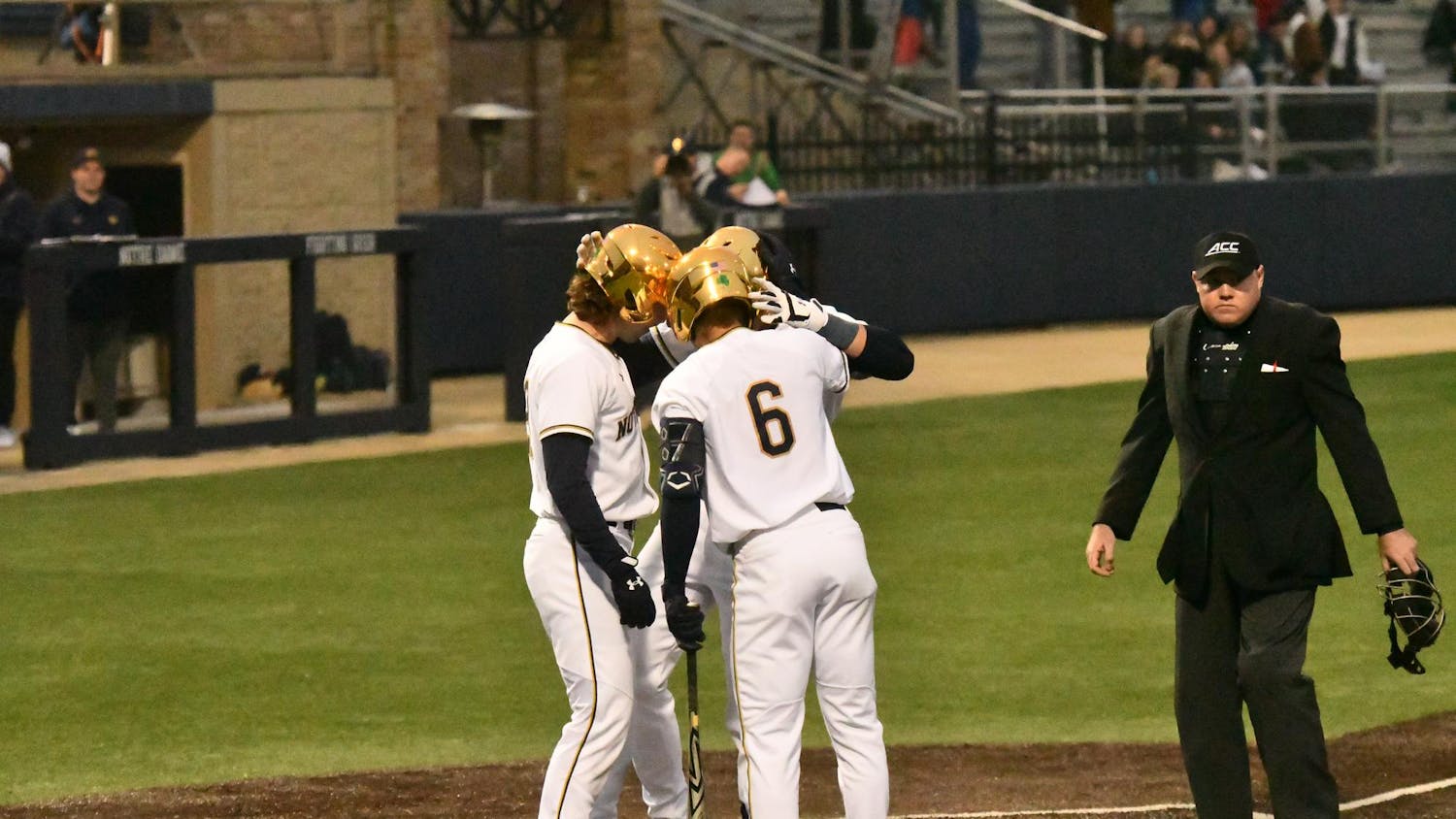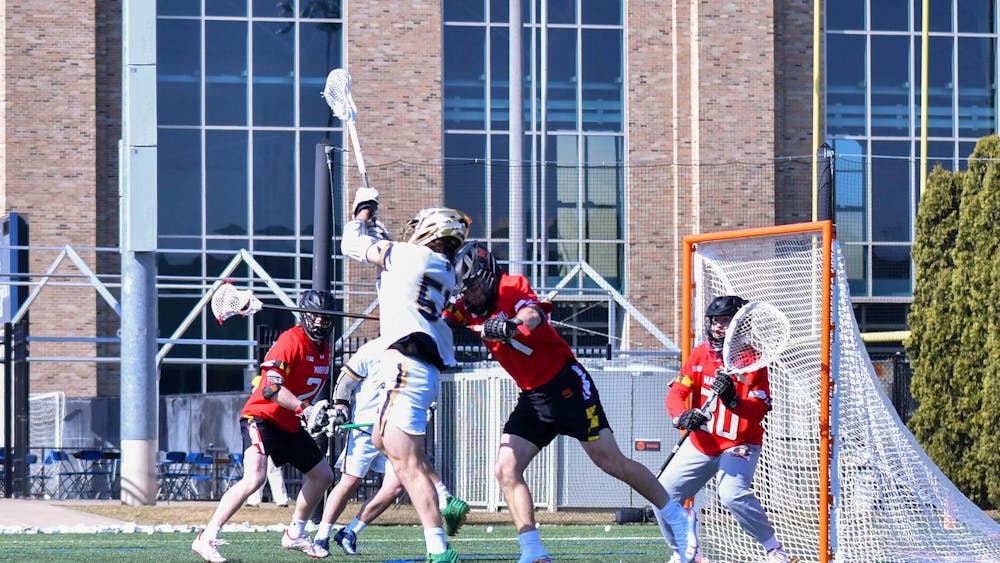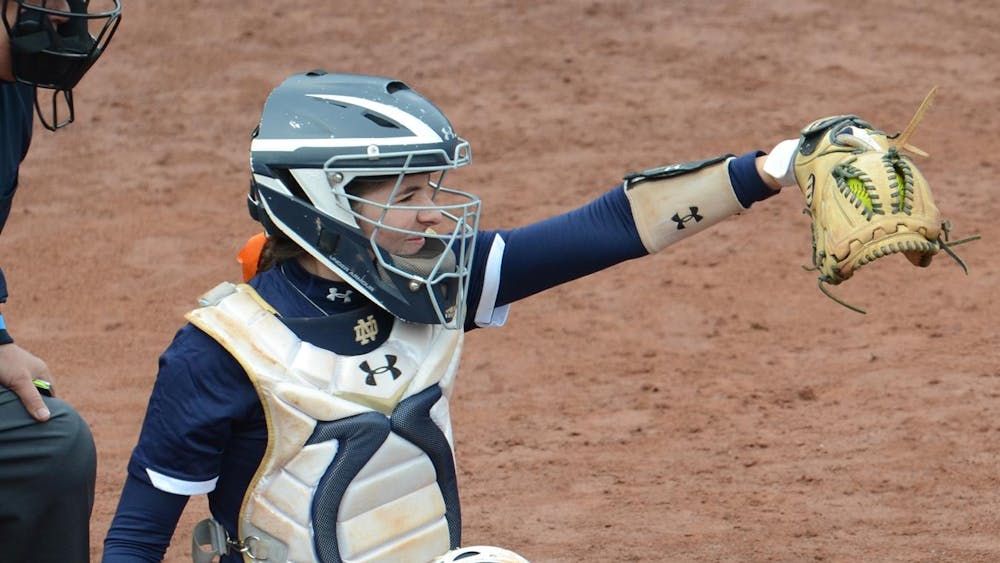Notre Dame isn't running up the score for promotional McDonald's vouchers anymore, but its 29-point average margin of victory in the 2012 NCAA tournament is reminiscent of its dominant performance during the regular season. The Irish start only one player over six feet tall, and yet outscore opponents inside the paint on a regular basis, including a Maryland team that started three in the regional finals.
There are no secret plays, no "Hoosiers" halftime speeches - just Irish coach Muffet McGraw's patented four-guard offense that has foiled height-advantaged opponents all season long.

"The four-guard lineup, it's just so versatile," senior guard Natalie Novosel said. "Everybody can score - it's so balanced. You can just do whatever you want, but at the same time it's a system, so there's different options. One person goes backdoor, one person cuts back out. There's just so many different options and it's so balanced."
Averaging 15.3 points per game as Notre Dame's second-leading scorer, Novosel has developed into one of the nation's most efficient players and junior guard SkylarDiggins' number-one option under McGraw's signature offense. While winning basketball games has been the most obvious effect of McGraw's implementation of the four-guard offense, her underlying motivation is much simpler.
"Because I love a high-scoring game as probably the other three coaches in this [Final Four would agree]," she said. "It's so much more fun to watch. I think it makes the game so much more exciting for the fans when you see up-tempo scoring also with great defense."
Notre Dame's path to the 2012 NCAA tournament national title may be remarkably similar to its successful championship run in 2001, but the vehicle responsible couldn't be more different. Take away the loss to Connecticut in the Big East tournament finals, the rematch in the Final Four, the consensus First Team All-American and the Hall-of-Fame coach, and you're left with two very different offensive systems driving the Irish.
"I think the players are more complete players [now]," McGraw said. "You used to have the defensive specialists [like] the 3-point shooter who couldn't guard. I think players now are so much better and so much more capable of playing the game at both ends, and it's great for the women's game."
The point guard

Every team needs one, but the Irish happen to have the nation's best. Averaging 16.7 points and 5.8 assists per game, Diggins lifted Notre Dame over the Terrapins with her first career triple-double to send the Irish to the tournament semifinals.
The point guard leads the Irish attack with her exceptional vision, quickness and versatility.
"Sky's the general of the court," Novosel said. "She just knows where everybody is - that's her job and she does it flawlessly. She's just really aware and does things really well."
Unlike a traditional Princeton offense that features four guards simultaneously directing the offense, Diggins' ability to dictate the Notre Dame offense on the court makes McGraw's system unique. The head coach said she has complete faith in Diggins to make the right pass, take the right shot and manage the game by herself.
"I give her complete control. I try to help her if I feel like she needs it, but she generally makes great decisions," McGraw said. "I really let her have a lot of flexibility to do what she can do because she's so talented and hard to guard."
In addition to letting Diggins facilitate her offense, McGraw added the coaching staff selects specific plays in particular to signal Diggins it's her time to take over a game. Diggins said the degree of flexibility granted to her by McGraw has been a developmental process.
"I have the green light. I think it's lime-green now in my junior year," she said.
The offensive threat
Named the Big East's Most Improved Player in 2011, Novosel has elevated her game to another level in her final season in uniform. The talented guard led the Irish in scoring in victories over California in the regional quarterfinals and St. Bonaventure in the regional semifinals, including a 28-point performance against the Golden Bears.
A native of Kentucky, Novosel said the four-guard system rattles opponents by creating mismatches that are difficult to guard and even harder to prepare for.
"Guards are quicker, faster, sometimes craftier with the ball, so I think it definitely creates a lot of problems for different people, especially those who are used to playing against two posts inside," she said. "Especially in transition, guards can coast down the court, and that's really tough to match up against."
McGraw said the luxury of having two prolific scorers in Diggins and Novosel prevents opponents from successfully double-teaming on defense.
"They're both just really tough matchups," she said. "They can score in a lot of different ways. They can score off the dribble, they get to the foul line and they make great passes."
The wild card
Sophomore guard Kayla McBride sat out the second half of the 2010-2011 season to attend to an off-the-court issue, watching Notre Dame's run to the national title game from the bench. In her first NCAA tournament game, she paced the Irish with a team-high 15 points in Notre Dame's victory over Liberty in the first round.
Afterwards, Liberty coach Carey Green called her the "wild card" of Notre Dame's offense.
"I think the four-guard look really makes it tough for that fourth defender for the other team. Kayla McBride's a tough matchup because she can go on the perimeter and hit threes, she can drive the ball and she can do so many things," McGraw said. "So if you try to put a post on her, she can take advantage of that."
Two seasons ago, 2010 graduate Lindsay Schrader served a similar role as a guard who could score in the frontcourt while remaining a shooting threat on the perimeter. However, McBride's defensive skill and 3-point shooting ability makes her even more versatile.
"K-Mac shoots a lot of threes and Lindsay really didn't, but she can still bang inside like Lindsay did," Diggins said. "It's different components."
The specialist
Ranked sixth all-time in program history with 150 career 3-point field goals, graduate student Brittany Mallory serves as Notre Dame's most potent threat behind the arc. Despite her recruitment by McGraw for her exceptional 3-point shooting, Mallory's experience in the four-guard system and off-ball movement has made her invaluable on the court.
"Brittany's the stabilizing force. She's the smart one," McGraw said. "She's going to go back-door, she's going to make a great cut. She's going to tell everybody to be in the right spot and make sure everybody's doing what they're supposed to be doing."
Mallory said the offense can't function properly if Notre Dame relies too heavily on the three-point shot. Rather, McGraw's system flourishes when the guards spread the floor and allow Diggins to find the open shooter or cutting player.
"When we spread the floor, that creates opportunities for driving, and when Sky drives everyone's going to look at her," she said. "We just have to look to get open and allow her to get us the ball."
The forward
Graduate student forward Devereaux Peters serves an important role as Notre Dame's lone conventional post player, attracting defenders to free up perimeter shooters while finding the backdoor cutters. An athletic forward like Peters who can run the floor and rebound makes McGraw's offense that much more effective.
"The guards really play well through me," Peters said. "We have found our niche, where we know each other and we play well together. I move a bit quicker than a lot of the posts, so it works to our advantage in our case."
Regardless of position, McGraw said her players' laser-like focus and motivation to return to the national championship game, coupled with their ability to coach themselves on the floor, set this year's team apart.
"This is a team that has taken ownership. They're accountable for each other, they help each other," she said. "They feel like they're coaches on the floor. When they see things they'll talk about, 'Hey, why don't we try this? This looks great. I see this. This is going to work.' I think it's a real team effort."
Contact Chris Masoud at cmasoud@nd.edu












